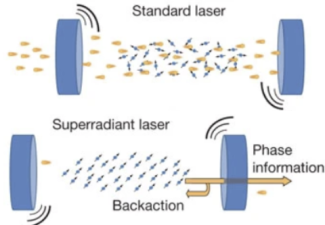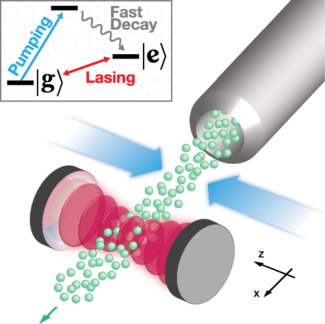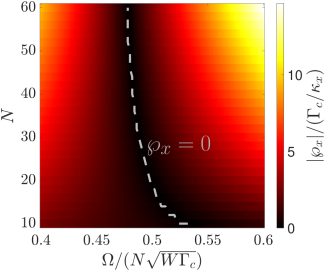Comparison of a traditional laser to a superradiant laser. Since, in the latter case, the phase information is stored in the atoms, superradiant lasers can be significantly more robust to thermal vibrations of the mirrors.
Proposal for a thermal beam setup in order to achieve continuous-wave superradiant lasing.
The dashed gray line depicts the locus of points where the cavity pulling coefficient completely vanishes even at steady-state in the SU(3) superradiant laing model.
Our research group is on the quest for the holy grail: an active superradiant atomic clock. Such clocks are so desirable for both practical and scientific reasons, and have the potential to push the precision of clock measurements to levels in which quantum gravitational effects can be studied. For one, the use of superradiant lasers instead of traditional lasers can greatly improve the phase coherence in the optical field of the clock system. This is because the system operates in the bad-cavity regime such that the output light is directly emitted from an ultra-narrow clock transition. By developing an active atomic clock based on this system, clock setups would no longer need additional probe lasers which restrict current experiments from exploiting the full potential offered by the stability of optical clock transitions. This could potentially achieve a lasing linewidth on the order of mHz which corresponds to a coherence length stretching from the Earth to the Sun. Furthermore, since the phase coherence of the output field is stored in the atoms rather than the cavity photons, the system becomes incredibly robust to thermal fluctuations of the reference cavity mirrors which is the main effect that limits the stability in traditional lasers.
Our group, in collaboration with the Ye lab, pioneered the idea of active superradiant atomic clocks in a trapped atom bad-cavity system. This proposal introduced an individual pumping scheme which allows the system to avoid problems from single-atom decoherence processes that would ruin previous proposals of fully collective two-level superradiant lasers. The use of individual pumping also significantly expands the parameter regime in which steady-state superradiance is achievable compared to fully collective superradiant lasers. With this proposed model, our group collaborated with the Thompson lab to achieve the first experimental realization of a superradiant laser. However, experimental realizations of superradiant lasers have so far been limited to the pulsed regime primarily due to atomic heating effects associated with the individual pumping scheme. To overcome these practical issues and achieve continuous-wave lasing, our group, in collaboration with the Nicholson lab out of the Center for Quantum Technologies in Singapore, have instead proposed a thermal beam configuration where atoms are excited before traversing the cavity mode. We collaborate with the Schreck lab from the University of Amsterdam to realize our thermal beam proposal in an experimental setting.
We have also addressed the heating problem in an alternate way by once again examining a fully collective pumping scheme. A fully collective pump mediated by an auxiliary cavity avoids atomic heating by effectively transferring the random momentum recoils to the massive cavity mirrors through radiation pressure forces. However, unlike previous fully collective two-level models that are known to lack a generic lasing transition, we demonstrated that multi-level effects in a three-level model can be exploited to achieve a large parameter regime of superradiant lasing. This is because, in a Λ-level configuration, collective pumping and lasing can be performed on two different transitions leading to a class of SU(3) [rather than SU(2)] rotations which can change the length of the collective dipole. The generated lasing states of our so-called SU(3) superradiant laser possess properties of our previous models such as an ultranarrow linewidth and robustness to single-particle decoherence. However, unlike previous models, multi-level effects in the SU(3) superradiant laser allows it to "lase without inversion" as the lasing mechanism now solely relies on inversion between dressed eigenstates. This, in turn, allows the system to achieve zero cavity pulling, i.e. the output light frequency is completely insensitive to the frequency of the cavity, even at steady-state which was not possible in previous two-level models as inversion is required for steady-state lasing. Our scheme can thus become completely insensitive to thermal or acoustic fluctuations which are the principal deleterious factors that limit the stability of state-of-the-art reference lasers.







